Pressure Canning Chicken | How To Do It Yourself
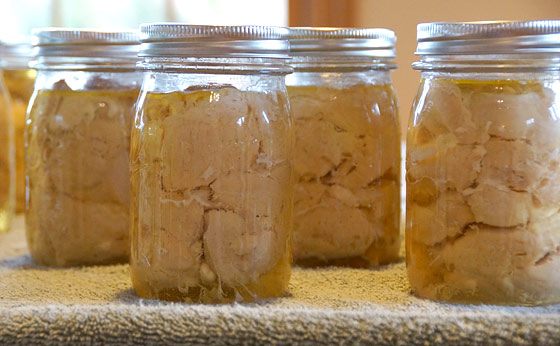
How Long To Pressure Can Chicken
First, I’ll get right to it. When pressure canning chicken, it takes 75 minutes at 11 psi for pint jars. 90 minutes for quart jars. That’s raw-pack chicken breast.
I just did another batch of 18 pints and updating this post to reflect more “how to” can chicken detail:
We bought 20 pounds of chicken breast the other day which was on sale at a deep discount. Although we do keep some meat stored in chest freezers, another way to preserve meat is by pressure canning it yourself. Long term storage of the jars require no refrigeration and is perfectly safe if you follow common sense practices and reliable recipes.
Pressure Canning Chicken Breast | How-to
Why a Pressure Canner?
First, when pressure canning chicken, meats (or any low acid food), the processing temperature must be 240 degrees-F to destroy bacterial spores that emit toxins.
Boiling water is only 212 degrees-F. However the temperature in a pressure canner will reach 240 degrees at 11 psi (dial gauge).
Here’s an altitude versus canning pressure chart in case you’re in the mountains:
Altitude | Pressure Chart for Canning Meat, Poultry, Fish, Seafood, and Soup
| Altitude (ft.) | Pressure (psi) |
| 0 – 2000 | 11 |
| 2001 – 4000 | 12 |
| 4001 – 6000 | 13 |
| 6001 – 8000 | 14 |
Pressure Canning Chicken | Raw Pack Method
I use the ‘raw pack’ method for pressure canning chicken. When the chicken ‘cooks’ in a pressure canner the jar will fill with the oils from the meat. You don’t need to add water. Here’s a photo of my recent batch of home canned chicken:
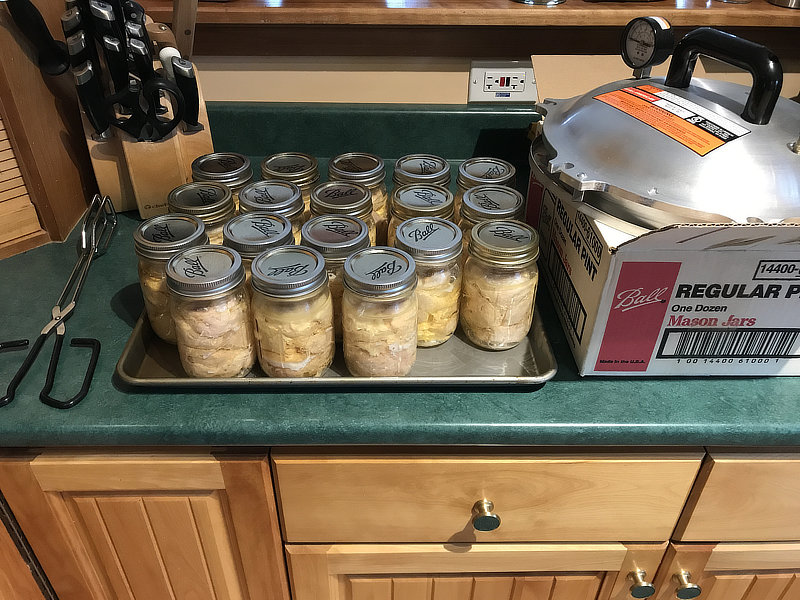
PREPARE JARS, LIDS, CANNER
JARS. I use pint jars. Each pint holds 1 pound of chicken. I simply prepared the jars by running them through a quick cycle in the dishwasher. Leave the door closed to keep the jars warm and take them out a few at a time to fill. Warm jars help prevent ‘cold shock’ (breakage) when the canning process starts.
LIDS. Place lids in a shallow pan on stove. Add water to cover the lids. Warm the pan of water to just below boiling (air bubbles on the bottom just starting to make their way to the surface). Done. Shut off heat. Note that if you place lids into hard boiling water, they caution that the sealing surface of the lids may become compromised. So don’t do that.
CANNER. Place on stove. I use the highest BTU burner for starters (I have a gas stove). Place tray in bottom of canner (keeps jars from sitting directly on the bottom). Add water to the lower ‘fill’ line. If canner does not have a water mark, fill to 2 inches from bottom. Turn on the burner to a low-mid setting. This saves time by starting to warm the water while you begin filling jars and place them in the canner.
Pro Tip: Add 2 tablespoons of white vinegar to canner water to prevent water stains on jars.
CUT CHICKEN TO FIT & FILL JARS
The size of the chicken slices doesn’t matter. I generally cut about 1 inch thick strips to lengths that will stuff into the jars. If doing this yourself, you might fill a large bowl with the chicken pieces first. Remember, the total amount of boneless chicken breast you need is about 1 pound per pint jar.
If you have a helper (as I do – Mrs.J), it’s easiest for one person to cut the chicken (me) and fill the jars while the other person does the rest (add salt, wipe jar lid surface, add lid, tighten the ring, place in canner). It’s more sanitary this way (one person handling raw chicken while wearing a pair of disposable gloves)
FILL JARS | HEADSPACE | SALT | LID & RING
FILL JARS. Okay now it’s time to fill the jars with chicken. Use a canning funnel (cheap at Walmart) to help fill the jar. This keeps the food off the jar rims (which will compromise a good seal). Mrs. J uses a little plastic spatula ‘thingy’ to tamp down the chicken into the jar while I add more chicken. This helps pack it to fit as much chicken as possible. DO NOT ADD WATER.
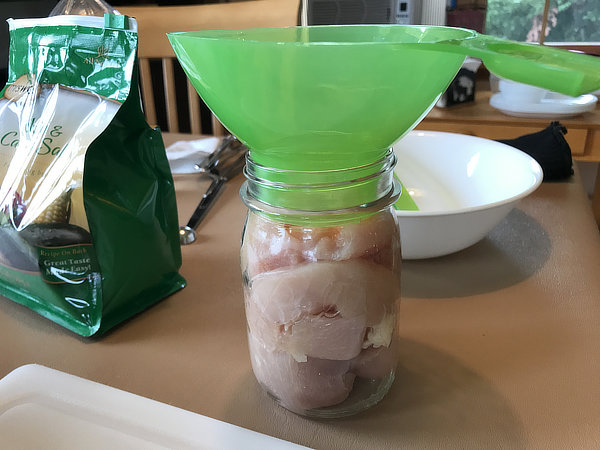
HEADSPACE. Leave a one-inch head-space from the top of the jar. See the image for reference:
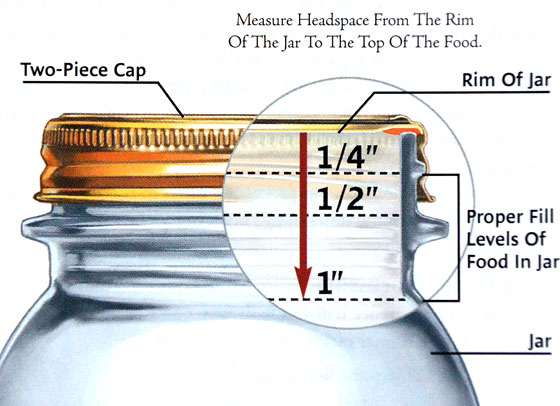
SALT. Optionally add 1/2 teaspoon of canning salt on top of the chicken (it will mix in while cooking). I do this for added flavor, and salt is also an added preservative. Note that ‘canning salt’ is salt without the added ‘filler’ that they use to prevent clumping. If you use regular salt it doesn’t ‘hurt’ anything, it will just become cloudy in the mixture after canning.
LID. Next, wipe the glass jar lid surface rim with a paper towel or clean cloth to ensure a clean seal. We moisten the cloth with white vinegar. Then use a magnetic lid lifter tool (very convenient!) to grab a lid out of the warm water bath and place on the jar.
RING / BAND. Screw on a ‘band’ over the lid and adjust (tighten) ‘finger tight’. The adjustment of the band (the tightness) should be firm and snug, but not too tight. Here’s a neat little tightener tool (which we use) which will set the tightness perfectly every time: Ball Jar Sure Tight Band Tool
FILL CANNER | DOUBLE STACK JARS
Double stack jars on top of each-other to maximize your production. It’s advisable (though not necessary) to insert a tray / stacking plate (rack) for the second stack to sit on. I bought one and use it now.
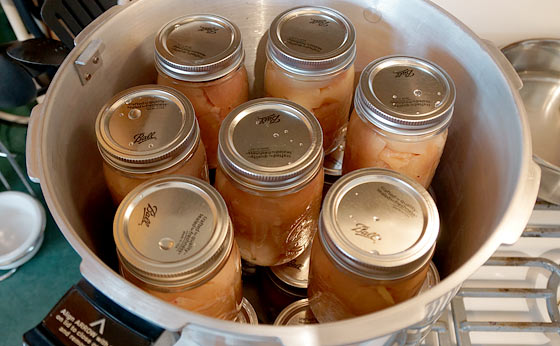
SECURE THE CANNER LID | STOVE ON | VENT STEAM |
When the pressure canner is full, securely attach the canner lid according to your canner instructions. Leave the vent pressure regulator weight OFF. Turn on the stove burner to high.
You must leave the weighted regulator OFF the vent in order to allow the chamber to release all of its air and fill completely with steam. When you begin to see steam shooting out of the vent, you must let it steam freely for 10 minutes. It takes a little while to get the filled pressure canner hot enough to make steam, but it’s a necessary step!
Here’s a picture of the steaming vent:
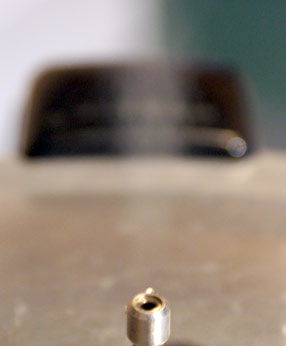
PRESSURIZE THE CANNER
After 10 minutes of venting the steam, place the weighted regulator over the steam vent. Now the canner will begin to pressurize. Watch the dial gauge and allow the pressure to increase to 11 pounds (see chart above for altitude variations).
You will eventually get used to your own stove and fiddling with the temperature control to maintain 11 pounds pressure (don’t let it drop below 11 once you’ve reached it).
START TIMER
When reaching 11 psi, begin a 75 minute timer if using pint jars. 90 minutes for quart jars.
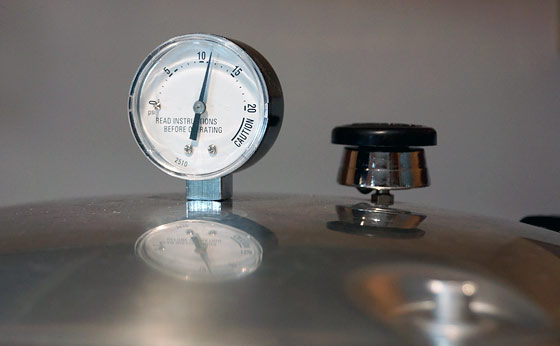
I find that even after initially getting the gas stove burner setting just right for 11 psi, the pressure will drift a bit. Just keep an eye on it.
Pro Tip: Slide the canner to a lower rated burner after it reaches 11 psi. This will enable better control while attempting to maintain proper pressure (you don’t need as much heat after it’s already up to temp.). Though it may be problematic for some because a filled canner is heavy!
TIMES UP | SHUT DOWN | COOL DOWN
After the appropriate canning time, simply shut off the burner. Let it sit there until the dial gauge pressure drops to zero! DO NOT REMOVE WEIGHTED PRESSURE REGULATOR until gauge reads zero.
REMOVE CANNER LID | JARS
After pressure gauge reads zero, you can remove the weighted pressure regulator from the vent to ensure release of residual pressure. Then open the canner and use a jar gripper tool to remove jars onto a counter on top of a towel.
Let the jars cool naturally. Don’t touch the lids. The lids will begin to self-seal as it cools. You’ll hear the popping sound as they seal.
REMOVE BANDS FOR STORAGE?
After the lids seal, some people will remove (unscrew) the bands. Why? Because it will be easier to detect if a lid becomes unsealed sometime later. A quick check of the lids by gently pulling on each one to ensure they’re still sealed. If the band was still screwed on, this would not be possible to check (without unscrewing each one).
With that said, it’s rare to have a jar unseal. Generally, if it’s going to be a problem it won’t seal to begin with.
STORE JARS | COOL & DRY
Store the final product in a cool dry place. Be cautious of bands becoming rusted if the environment is too humid.
MY TWO PRESSURE CANNERS
We now have two pressure canners. Our first was the Presto (still works great).
Presto 23-Quart Pressure Canner & Cooker
Several years ago we treated ourselves to the All American Pressure Canner (I wrote about it here).
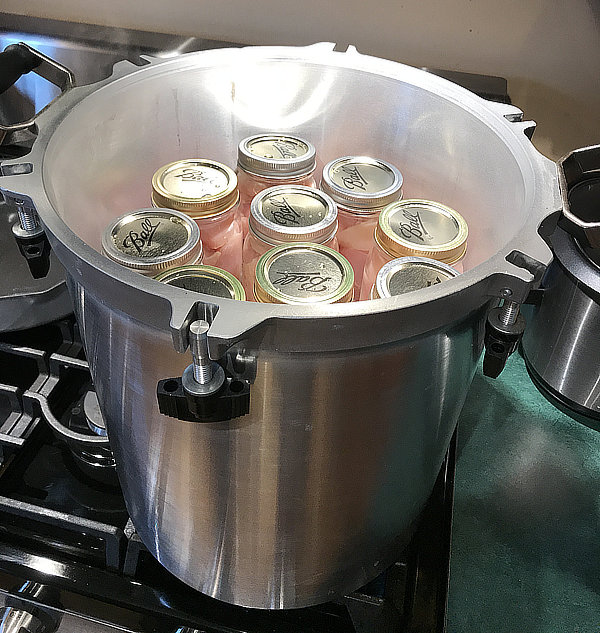
Continue reading: 5 Methods of Food Preservation
